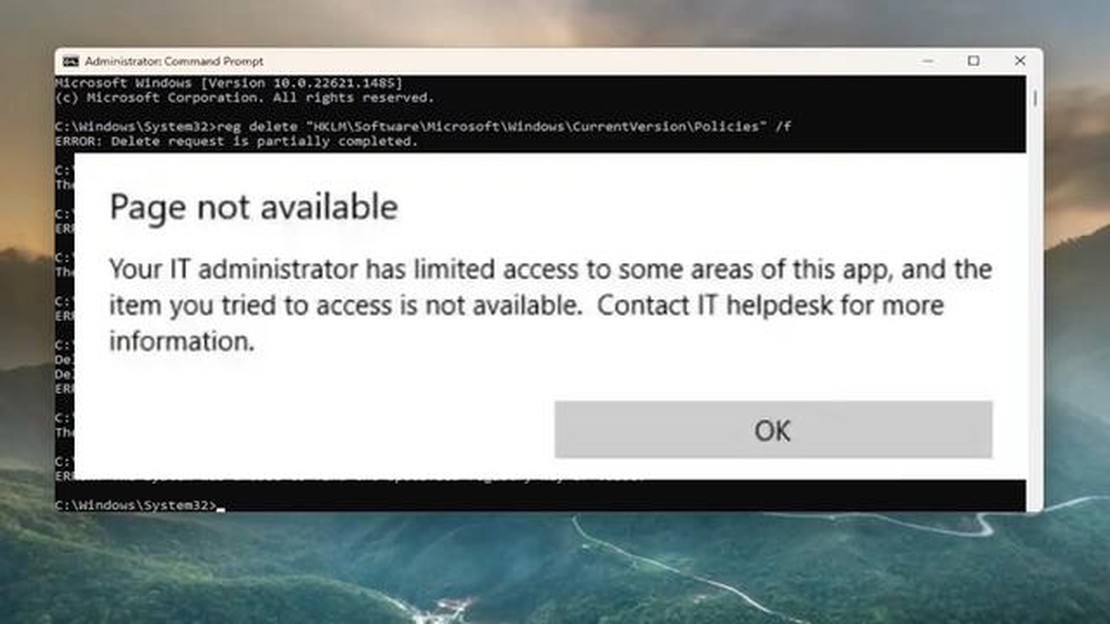Privacy concerns: Law enforcement used a facial recognition app
Law enforcement agencies use facial recognition app with big privacy concerns Privacy and personal data protection issues have become a hot topic in …
Read Article
Are you encountering the frustrating “Your IT Administrator Has Limited Access” error on your Windows computer? This error message often appears when you are trying to access certain settings or perform specific actions on your device. It can be a major roadblock in getting things done, especially if you need administrator rights to perform important tasks. Fortunately, there are several solutions that can help you fix this error and regain full access to your computer.
In this step-by-step guide, we will walk you through the process of resolving the “Your IT Administrator Has Limited Access” error on Windows. Whether you are using Windows 10, 8, or 7, the troubleshooting steps outlined in this article should be applicable. Please note that some of the solutions may require administrative privileges, so make sure you have the necessary permissions or consult with your IT department if you are using a work computer.
Before we delve into the solutions, let’s explore the possible causes of the “Your IT Administrator Has Limited Access” error. This will help us better understand the problem and choose the appropriate troubleshooting steps.
One possible cause of this error is a misconfiguration in the Group Policy settings on your device. Group Policy is a feature in Windows that allows administrators to manage and control various settings on multiple computers within a network. If there is a conflict or error in the Group Policy settings, it can lead to the “Your IT Administrator Has Limited Access” error.
Another potential cause is a problem with your user account or the permission settings associated with it. If your account does not have the necessary administrative privileges, you may encounter this error when trying to perform certain tasks. Additionally, if the permission settings for specific files or folders are incorrect, it can also trigger the “Your IT Administrator Has Limited Access” message.
Now that we have identified some possible causes, let’s begin troubleshooting and fixing the error step by step!
If you encounter the “Your IT Administrator Has Limited Access” error, the first thing you should do is check your network connection. A weak or unstable network connection can often be the cause of this error message. Here are some steps you can take to troubleshoot your network connection:
Read Also: How to Fix Undisputed Crashing on PC - Tips and Solutions
By checking your network connection and following the above troubleshooting steps, you can hopefully resolve the “Your IT Administrator Has Limited Access” error and regain normal network access.
If you’re experiencing the “Your IT Administrator Has Limited Access” error on your Windows computer, one of the possible solutions is to reset your network settings. This can help fix any network-related issues that might be causing the error.
To reset your network settings, follow these steps:
After the restart, you might need to reconnect to your Wi-Fi network or re-enter your network credentials if required. Make sure you have the necessary information handy before resetting your network settings.
This process will reset all your network settings, including Wi-Fi networks, VPN connections, and ethernet configurations. It will also remove any network adapters you have installed and their settings.
Resetting your network settings can sometimes resolve the “Your IT Administrator Has Limited Access” error. If the error persists, you might need to try other troubleshooting methods or contact your IT administrator for further assistance.
Read Also: Clear PS4 Cache: Easy Steps to Fix Issues in 2023
If you encounter the error message “Your IT Administrator Has Limited Access,” it is best to reach out to your IT administrator for assistance. They will have the necessary privileges and knowledge to address the issue effectively. Here are a few steps you can take:
Remember, your IT administrator is there to support you and ensure the smooth operation of your computer systems. Contacting them directly is the most effective way to resolve the “Your IT Administrator Has Limited Access” error.
The error message “Your IT Administrator has limited access” means that your computer is being managed by an IT administrator who has restricted certain actions or settings on your device.
You are seeing this error message because your computer is being managed by an IT administrator who has imposed restrictions on your device. These restrictions are in place to maintain security and prevent unauthorized actions or changes to the system.
Attempting to bypass the restrictions imposed by your IT administrator is not recommended and may be a violation of your organization’s policies. It is best to communicate with your IT administrator and explain your needs or concerns. They may be able to provide alternative solutions or make necessary adjustments to the restrictions if it is appropriate.
Law enforcement agencies use facial recognition app with big privacy concerns Privacy and personal data protection issues have become a hot topic in …
Read ArticleUninstalling riot vanguard in windows 11. With the growing popularity of Valorant by Riot Games, the question of how to uninstall Riot Vanguard, an …
Read ArticleHow To Track A Samsung Phone For Free Do you ever find yourself in a situation where you can’t find your Samsung phone? Maybe you misplaced it or it …
Read ArticleGalaxy S7 can’t encrypt SD card, other issues The Samsung Galaxy S7 is a popular smartphone that offers many features and capabilities. However, like …
Read Article7 Best Basic Flip Phones in 2023 As technology continues to evolve and smartphones become more advanced with each passing year, there is still a …
Read ArticleHow to assign a ringtone to a contact on Galaxy S10 | easy steps to set up ringtone to a contact Changing ringtones for specific contacts on your …
Read Article